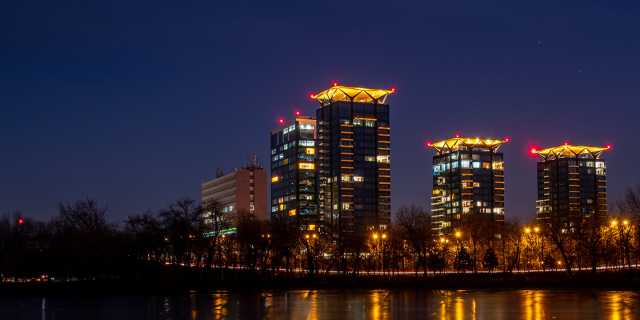Ryugyong Hotel
Although one of the countries that impose extremely strict rules on tourism, North Korea embarked on an ambitious project in 1987 that would serve this particular industry: building the tallest hotel in the world at the time, with a height of 330 meters. The construction took the form of a pyramid and came as a response to a project by a company in rival country South Korea, which had already built the tallest hotel in the world in Singapore. Ryugyong Hotel was to be structured, with Russian funding, on 105 floors, with three wings to house rooms for thousands of visitors, as well as five restaurants with panoramic views. However, the funds were blocked when the USSR collapsed in 1991. It was not until 2008 that the project caught the eye of an Egyptian company, which invested USD 180 million in equipping the LED facade used today to project Pyongyang government messages and various scenes from the country’s history. However, the completion of the project would involve a significant cost of about USD 2 billion. Meanwhile, the building was included in the Guinness Book as the tallest unoccupied building in the world.
Golding Finance 117
Started in 2008 in China, the construction of the Golden Finance 117 skyscraper has since become impossible to complete. Initially, it was to become the second tallest building in the world, after the famous Burj Khalifa. In 2015, when the project had already reached a height of 597 meters, the constructor went bankrupt. Three years later, attempts were made to resume work, but without success. It was the last chance to complete the project, and that's because in the spring of 2020 the authorities decided to ban the construction of skyscrapers higher than 500 meters.
Doha Shark Crossing
Doha Shark Crossing is part of the Doha government's planned infrastructure projects following the designation of Qatar as the host country for the 2022 FIFA World Cup. Announced back in 2013, it was initially named Doha Bay Crossing and was designed with a length of 12 kilometers, consisting of three bridges interconnected by underwater tunnels. With a capacity of 6,000 vehicles per hour, the project would ensure fast traffic between Hamad International Airport and the exclusive West Bay neighborhood, located on the shores of the Persian Gulf. The initial budget allocated was made of a USD 12 billion investment for completion, but just two years after work began, several factors made it impossible to continue. Reasons included declining oil prices and overcrowding in the construction sector due to population growth and high demand for residential projects. After another four years, however, the government reconsidered its decision to postpone all non-essential projects and gave the green light to the resumption of construction, and in 2020 announced that it would allocate USD 140 billion to complete the passage. However, the construction will not be ready before the sporting event because it will take about four years to complete.
London Garden Bridge
London is already known for the imposing bridges that connect Thames’s banks. For this reason, when the government announced in 2012 the construction of a new bridge concept, originally proposed in the 1990s by actress Joanna Lumley, which involved exorbitant costs, journalists harshly criticized the project. London Garden Bridge would have been 366 meters long and would have required USD 85 million in funding, much more than the Millennium Bridge, a similarly sized building in which only USD 25 million was invested. Unlike other London bridges, London Garden Bridge was to be a pedestrian bridge with green areas and rich gardens, attracting around 3 million tourists annually. In addition, the initial plans were to complete the project entirely with the help of private investment. In 2015, however, costs had risen to USD 260 million, of which 85 should have been funded by the state. After another two years, the designers announced that the required investment had increased even more, to USD 280 million, and the funds raised were only USD 180 million, so the works were not started. Even if the construction was yet to begin, the bridge still brought, even in the project phase, massive losses of about USD60 million.
Xiangyun International Project
Located in the Chinese province of Hubei, the Xiangyun International Project has become a ghost town ever since work was cancelled. The initially announced investment was USD 17 billion, and the project was to be structured into two main areas - one residential and one for leisure, both with parking lots, shopping malls and European-style buildings. In 2014, however, the company responsible for the project went bankrupt, after its management was accused of corruption. At that time, 700 homes were already sold and an important part of the project was completed. The Xiangyun International Project has begun to deteriorate and there are no signs that work will ever resume.
Data for this article was obtained from Top Luxury channel and Wikipedia.org.
More on our blog
- One Insider
- Real estate: past, present and future
- Layout and style
- Real estate education
- Free time in Bucharest
- Tourist attractions in Bucharest
- The neighborhoods of Bucharest
Read also






